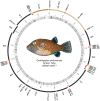Skimming for barcodes: rapid production of mitochondrial genome and nuclear ribosomal repeat reference markers through shallow shotgun sequencing
- PMID: 35959477
- PMCID: PMC9359134
- DOI: 10.7717/peerj.13790
Skimming for barcodes: rapid production of mitochondrial genome and nuclear ribosomal repeat reference markers through shallow shotgun sequencing
Abstract
DNA barcoding is critical to conservation and biodiversity research, yet public reference databases are incomplete. Existing barcode databases are biased toward cytochrome oxidase subunit I (COI) and frequently lack associated voucher specimens or geospatial metadata, which can hinder reliable species assignments. The emergence of metabarcoding approaches such as environmental DNA (eDNA) has necessitated multiple marker techniques combined with barcode reference databases backed by voucher specimens. Reference barcodes have traditionally been generated by Sanger sequencing, however sequencing multiple markers is costly for large numbers of specimens, requires multiple separate PCR reactions, and limits resulting sequences to targeted regions. High-throughput sequencing techniques such as genome skimming enable assembly of complete mitogenomes, which contain the most commonly used barcoding loci (e.g., COI, 12S, 16S), as well as nuclear ribosomal repeat regions (e.g., ITS1&2, 18S). We evaluated the feasibility of genome skimming to generate barcode references databases for marine fishes by assembling complete mitogenomes and nuclear ribosomal repeats. We tested genome skimming across a taxonomically diverse selection of 12 marine fish species from the collections of the National Museum of Natural History, Smithsonian Institution. We generated two sequencing libraries per species to test the impact of shearing method (enzymatic or mechanical), extraction method (kit-based or automated), and input DNA concentration. We produced complete mitogenomes for all non-chondrichthyans (11/12 species) and assembled nuclear ribosomal repeats (18S-ITS1-5.8S-ITS2-28S) for all taxa. The quality and completeness of mitogenome assemblies was not impacted by shearing method, extraction method or input DNA concentration. Our results reaffirm that genome skimming is an efficient and (at scale) cost-effective method to generate all mitochondrial and common nuclear DNA barcoding loci for multiple species simultaneously, which has great potential to scale for future projects and facilitate completing barcode reference databases for marine fishes.
Keywords: Collections; DNA barcoding; Fishes; Genome skimming; Metabarcoding; Mitochondrial genomes; Museum.
©2022 Hoban et al.
Conflict of interest statement
The authors declare there are no competing interests.
Figures



Similar articles
-
Nuclear eDNA metabarcoding primers for anthozoan coral biodiversity assessment.PeerJ. 2024 Nov 26;12:e18607. doi: 10.7717/peerj.18607. eCollection 2024. PeerJ. 2024. PMID: 39619181 Free PMC article.
-
Cost-efficient PCR based DNA barcoding of marine invertebrate specimens with NovaSeq amplicon sequencing.Mol Biol Rep. 2024 Aug 6;51(1):887. doi: 10.1007/s11033-024-09811-z. Mol Biol Rep. 2024. PMID: 39105821
-
Biodiversity of Philippine marine fishes: A DNA barcode reference library based on voucher specimens.Sci Data. 2023 Jun 24;10(1):411. doi: 10.1038/s41597-023-02306-9. Sci Data. 2023. PMID: 37355644 Free PMC article.
-
The campaign to DNA barcode all fishes, FISH-BOL.J Fish Biol. 2009 Feb;74(2):329-56. doi: 10.1111/j.1095-8649.2008.02080.x. J Fish Biol. 2009. PMID: 20735564 Review.
-
DNA barcode reference libraries for the monitoring of aquatic biota in Europe: Gap-analysis and recommendations for future work.Sci Total Environ. 2019 Aug 15;678:499-524. doi: 10.1016/j.scitotenv.2019.04.247. Epub 2019 Apr 27. Sci Total Environ. 2019. PMID: 31077928 Review.
Cited by
-
Phylogenetic taxonomy of the Zambian Anopheles coustani group using a mitogenomics approach.Malar J. 2025 Jul 1;24(1):203. doi: 10.1186/s12936-025-05461-z. Malar J. 2025. PMID: 40597261 Free PMC article.
-
Endemic Radiation of African Moonfish, Selene dorsalis (Gill 1863), in the Eastern Atlantic: Mitogenomic Characterization and Phylogenetic Implications of Carangids (Teleostei: Carangiformes).Biomolecules. 2024 Sep 25;14(10):1208. doi: 10.3390/biom14101208. Biomolecules. 2024. PMID: 39456141 Free PMC article.
-
Mitogenomic Characterization and Phylogenetic Placement of African Hind, Cephalopholis taeniops: Shedding Light on the Evolution of Groupers (Serranidae: Epinephelinae).Int J Mol Sci. 2024 Feb 2;25(3):1822. doi: 10.3390/ijms25031822. Int J Mol Sci. 2024. PMID: 38339100 Free PMC article.
-
Skimming genomes for systematics and DNA barcodes of corals.Ecol Evol. 2024 May 13;14(5):e11254. doi: 10.1002/ece3.11254. eCollection 2024 May. Ecol Evol. 2024. PMID: 38746545 Free PMC article.
-
Optimal input DNA thresholds for genome skimming in marine crustacean zooplankton.PeerJ. 2025 Feb 26;13:e19054. doi: 10.7717/peerj.19054. eCollection 2025. PeerJ. 2025. PMID: 40028195 Free PMC article.
References
-
- Alexander JB, Bunce M, White N, Wilkinson SP, Adam AAS, Berry T, Stat M, Thomas L, Newman SJ, Dugal L, Richards ZT. Development of a multi-assay approach for monitoring coral diversity using eDNA metabarcoding. Coral Reefs. 2020;39:159–171. doi: 10.1007/s00338-019-01875-9. - DOI
-
- Alsos IG, Lavergne S, Merkel MKF, Boleda M, Lammers Y, Alberti A, Pouchon C, Denoeud F, Pitelkova I, Puşcaş M, Roquet C, Hurdu B-I, Thuiller W, Zimmermann NE, Hollingsworth PM, Coissac E. The treasure vault can be opened: large-scale genome skimming works well using herbarium and silica gel dried material. Plants. 2020;9:432. doi: 10.3390/plants9040432. - DOI - PMC - PubMed
-
- Berry TE, Osterrieder SK, Murray DC, Coghlan ML, Richardson AJ, Grealy AK, Stat M, Bejder L, Bunce M. DNA metabarcoding for diet analysis and biodiversity: A case study using the endangered Australian sea lion (Neophoca cinerea) Ecology and Evolution. 2017;7:5435–5453. doi: 10.1002/ece3.3123. - DOI - PMC - PubMed
Publication types
MeSH terms
Substances
LinkOut - more resources
Full Text Sources

